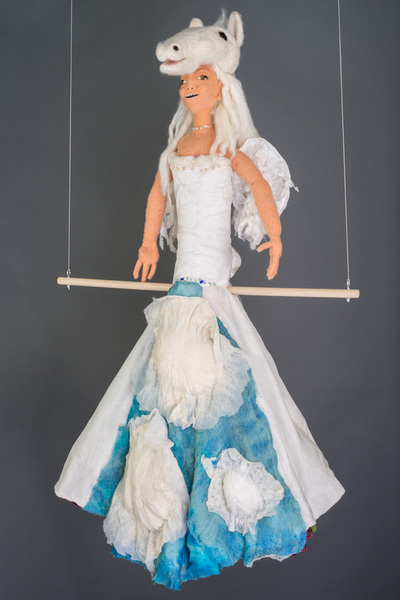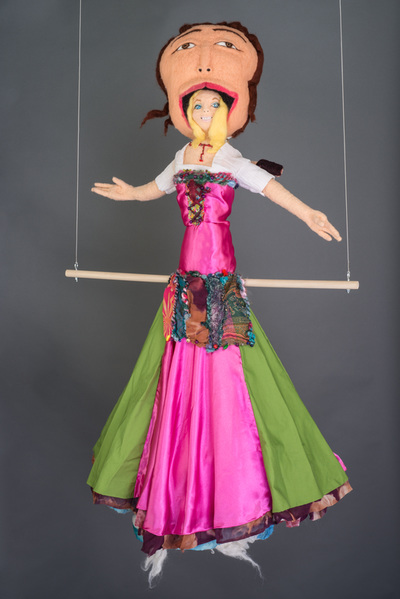|
Putting it in context: Back in November I shared here about the flip doll show I coordinated together with artists Susan Sherwin and Sheep Jones. Since then, I've been working on something new that I haven't shared here yet. Today I want to begin to tell you about this new project I've been working on and also about the grant I am applying for which will enable me to do even more with this project. Conant Grant: Over the past few months I've been working on putting together a grant so that I can study more about flip or topsy turvy dolls and their history, work on making more flip dolls of my own and offer a series of classes at a homeless shelter for women here in DC called N. Street Village. So far, what's happened is that I've gotten through the first phase of the grant and am about to submit my full proposal for the second phase of the grant. I've decided however that whatever happens, I'm still going to do this project. The grant is funded by the Potomac Fiber Arts Guild, of which I've been a member for the past year and a half or so. N Street Village is a lovely place offering a wide variety of services including housing, activities, social services, nutritional counseling, and much more to women who suffer from homelessness. I heard about it from another artist at the Jackson Art Center, where I've been making my dolls since last May. Jackson Art Center also has an outreach program and they've done some work with N. Street in the past. More about flip dolls: Flip or Topsy-turvy dolls are two sided dolls connected in the middle at the waist, and separated by a skirt, which flips over to cover one side when the other side is revealed. First appearing as dolls made by slave girls in the south during the Civil War era, the dolls reinforced stereotypes of black subjugation to whites. They evolved later into story-telling dolls in the U.S. and abroad. The origin of the flip doll is controversial. There aren’t any clear understandings of how the original black/white flip dolls were used. Some say that black slave mothers created them for their little girls to play with. In this version of the story, the two-sided doll allowed whoever was playing with it to hide the white doll when the white owners came around. Other sources state that the flip doll was created for white daughters of slave owners, so that they could have the black side of their doll as servants for their white dolls. In any case, the dolls carry with them the taint of the history of slavery and the poor treatment of blacks during the Civil War era of our history. One of the first black/white dolls was inspired by the characters of Topsy and little Eva, in Harriet Beecher Stowe’s, Uncle Tom’s Cabin. This is how the alternate name of this doll, Topsy/turvy doll, evolved. I’ve discovered in my research that the flip doll continues to have its claim on the imagination of artists and children alike. In one sense, the dolls evolved into another form, leaving the black/white stigma behind and becoming a means of telling stories. These story telling dolls had their renaissance in the Appalachian region of North Carolina, where folk schools and craft centers created “story telling flip dolls” using the two sided nature of the doll to tell stories that contained opposites, such as Little Red Riding Hood and the Wolf, Snow White and the Seven Dwarfs, Goldilocks and the Three Bears, sometimes combining multiples smaller dolls on either side of the doll. My idea: From my proposal, here are the three main strands of what I want to be working on for this project.
I'll be posting more about this as it develops. I hope to use my posting here on my blog about this project for several purposes-to keep you up to date on what's happening with this project and to keep myself accountable as things move along. Here are some things I have to think about in the next few days. 1. make a list of questions to ask the artists that I am planning to interview. 2. plan actual sessions with the N. Street Villagers. I will also be offering a flip doll workshop at the Smith Center on May 21st. That will also help me get my ideas rolling. 3. start gathering supplies for all of this. And lots lots more.
0 Comments
|
ErikaI've been making dolls for about ten years now. I believe that dolls serve as representations and reminders of the best part of ourselves. I am excited to share with you here my learnings about new methods and techniques for doll making and healing. So glad you are here! Categories |
Proudly powered by Weebly


 RSS Feed
RSS Feed